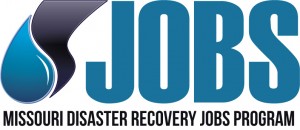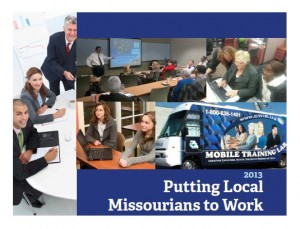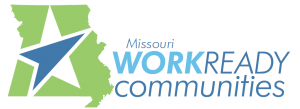A community’s workforce is of fundamental importance for economic growth. To meet the needs of today’s companies, and to sufficiently educate workers for the demands of the knowledge economy, economic development organizations must collaborate with workforce development organizations and other stakeholders, including their partners in business and education. [Read more…]
Transitioning skills in disaster-impacted communities
 The International Economic Development Council plans to showcase Missouri’s experience in disaster recovery in a webinar November 20th. This virtual event provides a how-to introduction on developing workforce training programs in disaster-impacted communities.
The International Economic Development Council plans to showcase Missouri’s experience in disaster recovery in a webinar November 20th. This virtual event provides a how-to introduction on developing workforce training programs in disaster-impacted communities.
A major disaster can disrupt market flows and impact local businesses in ways beyond the imagination. Either temporary business closures or permanent business relocations can cause major redundancies for the local workforce as well as discourage new talent from moving into the impacted communities. The situation can also exacerbate difficulties faced by disadvantaged populations.
This webinar will explore how economic developers can work with workforce development organizations to develop and implement new training programs that are based on changing market realities caused by the event. Learn about the process to identify skills to address business needs that help to strengthen the region’s recovery and growth prospects. Speakers will present case examples from Joplin, Missouri following their EF-5 tornado and Katrina- impacted communities.
Attendees will learn:
- How to leverage additional federal funds to support workforce systems already in place
- About best practices to engage private employers in your workforce training efforts
- Strategies to tie disaster recovery workforce initiatives to growing industrial sectors/clusters within your region.
Presenters include Jasen Jones with the Southwest MO WIB and Barbara Johnson, one of the leaders in the Katrina recovery effort. More information on the webinar and how to participate may be found online at http://restoreyoureconomy.org/developing-workforce-training-programs-webinar/.
Real estate magazine profiles Missouri CWRC
 Site Selection magazine’s July 2013 edition includes a profile on Missouri’s Certified Work Ready Communities initiative. Site Selection provided background on CWRC, Joplin’s success in rebounding from the tornado disaster, and plans for the future. The article includes a graphic on the first 14 counties to participate in Missouri. The article runs on pages 139-140. The digital edition of the magazine is available as a web-based application online.
Site Selection magazine’s July 2013 edition includes a profile on Missouri’s Certified Work Ready Communities initiative. Site Selection provided background on CWRC, Joplin’s success in rebounding from the tornado disaster, and plans for the future. The article includes a graphic on the first 14 counties to participate in Missouri. The article runs on pages 139-140. The digital edition of the magazine is available as a web-based application online.
Site Selection magazine is an internationally circulated business publication covering corporate real estate and economic development. Published six times a year by Conway Data Inc., the magazine reaches more than 43,000 qualified subscribers with timely news, information and analysis on significant industrial facility expansion activity and site location trends worldwide. Subscribers are high-level corporate executives with decision-making responsibility for business locations.
NCRC helps Missourians work sooner, earn more
 Many advocates of credential based hiring have long held that jobseekers will earn higher wages or salaries commensurate to higher scores on credentials such as the National Career Readiness Certificate. Frank Neely from the WIB of Southwest Missouri led joint efforts with Mayo Enterprises and the Missouri Division of Workforce Development to put this theory to the test.
Many advocates of credential based hiring have long held that jobseekers will earn higher wages or salaries commensurate to higher scores on credentials such as the National Career Readiness Certificate. Frank Neely from the WIB of Southwest Missouri led joint efforts with Mayo Enterprises and the Missouri Division of Workforce Development to put this theory to the test.
The research partnership examined the average earnings, entered employment, and retention rates by NCRC and education levels of Adult enrolled clients over three years. The results quantifiably demonstrate the benefits to jobseekers that choose to demonstrate their skills via the completion of such assessments. The WIB published the monograph now available for download detailing the performance for NCRCs throughout Missouri.
The research focused on customers of the Missouri one-stop career center system comparing job seekers with the NCRC and those without. While it’s natural to conclude that education advancement improves average earnings, additional education coupled with the NCRC propels earning potential even further, according to the report. Three years worth of data also demonstrates that workforce center customers with higher NCRC scores are more likely to get back to work. Employment Retention, the measure for the likelihood that customers stay in a job longer, also shows improvement with each level of the NCRC, though not as dramatic as the Entered Employment and the Average Earnings measures.
The report acknowledges special contributions by Dr. Merrilea Mayo of Mayo Enterprises and a lead strategist for New Options New Mexico. Brenda Ancell and Roger Baugher from the Missouri Division of Workforce Development provided valuable data sourcing and analysis for the project as well.
- Download the full report online in PDF
- More about the NCRC in Missouri
- Missouri Certified Work Ready Communities
Booklet and video chronicles success of Disaster Recovery Jobs Program
 A four-color, 24-page report is now available online describing the critical role of Missouri’s Disaster Recovery Jobs Program (MoDRJP) in putting workers displaced by tornadoes and floods back to work and speeding local recovery efforts. MoDRJP arose through a collaboration organized by the Division of Workforce Development (DWD) including the Missouri National Guard (MONG); city, county, and non-profit agencies; nine Local Workforce Investment Boards (LWIBs); the U.S. Department of Labor; local businesses; and educational institutions.
A four-color, 24-page report is now available online describing the critical role of Missouri’s Disaster Recovery Jobs Program (MoDRJP) in putting workers displaced by tornadoes and floods back to work and speeding local recovery efforts. MoDRJP arose through a collaboration organized by the Division of Workforce Development (DWD) including the Missouri National Guard (MONG); city, county, and non-profit agencies; nine Local Workforce Investment Boards (LWIBs); the U.S. Department of Labor; local businesses; and educational institutions.
The benefits of MoDRJP went far beyond employment. In repairing more than 1,500 miles of gravel roads and levees, removing hundreds of tons of debris, restoring parks, coordinating volunteers and managing donations, many lives and local economies were profoundly altered. A companion 35-minute video on DWD’s YouTube channel provides an overview of MoDRJP, including interviews with key players and work-site participants.
Workforce Day at the Capital Postponed
 Training and Employment Administrators of Missouri (TEAM) and the Missouri Association for Workforce Development (MAWD) joined forces to hold a breakfast reception for Missouri’s General Assembly and staff. A winter storm prevented the event from happening as planned on February 21st. A new date will be announced soon. The event will occur in the third floor rotunda at the Capital building from 7:30 to 10:00 a.m. Now in its second year, TEAM and MAWD hold the event to thank elected officials for the work they do on behalf of Missouri’s employers.
Training and Employment Administrators of Missouri (TEAM) and the Missouri Association for Workforce Development (MAWD) joined forces to hold a breakfast reception for Missouri’s General Assembly and staff. A winter storm prevented the event from happening as planned on February 21st. A new date will be announced soon. The event will occur in the third floor rotunda at the Capital building from 7:30 to 10:00 a.m. Now in its second year, TEAM and MAWD hold the event to thank elected officials for the work they do on behalf of Missouri’s employers.
This year, TEAM and MAWD published a special report titled, Putting Local Missourians to Work for distribution at the Capital event. The report provides a general overview of Missouri’s local workforce system, its impact on Missouri’s economy, and examples of excellence from each of Missouri’s local workforce regions. The publication includes brief organizational profiles on TEAM and MAWD along with priorities for workforce system reform. The report may be downloaded online as a printer-friendly PDF.
Report showcases excellence of Missouri’s local workforce system
 Strong leadership with increased capacity of the local workforce system puts more Missourians back to work sooner. That’s the focus of a new report published by the Training and Employment Administrators of Missouri. Putting Local Missourians to Work is the title of the 24-page report that provides added focus on the examples of excellence and impact in each of Missouri’s local workforce regions.
Strong leadership with increased capacity of the local workforce system puts more Missourians back to work sooner. That’s the focus of a new report published by the Training and Employment Administrators of Missouri. Putting Local Missourians to Work is the title of the 24-page report that provides added focus on the examples of excellence and impact in each of Missouri’s local workforce regions.
The publication opens with the importance of workforce development for Missouri’s overall economy, the necessity of regionalized workforce systems driven by local needs, and the value of the partnerships with educators, state agencies, and elected officials. The opening section also highlights performance metrics such as volume of customers, veterans, job openings, re-employment, and credentials. A page is devoted to each of Missouri’s 14 workforce regions. Enriching each profile is a variety of customer and stakeholder testimonials along with articles on projects that make a difference to communities throughout the Show-Me State.
TEAM included brief organizational profiles of both TEAM and the Missouri Association of Workforce Development. The report also introduces a summary of strategies for meaningful reform of the workforce system at both national and state levels. The report can be downloaded as a PDF online.
Conference marks official launch of Certified Work Ready Communities
 Certified Work Ready Communities (CWRC) in Missouri is a voluntary initiative guided by key community leaders (local elected officials, economic development, business leaders, chambers, educators, and workforce development). Whether a town is large or small, the community will be able to attract, retain, and develop a workforce with the education and foundational skills to succeed in the 21st century by utilizing the National Career Readiness Certificate (NCRC).
Certified Work Ready Communities (CWRC) in Missouri is a voluntary initiative guided by key community leaders (local elected officials, economic development, business leaders, chambers, educators, and workforce development). Whether a town is large or small, the community will be able to attract, retain, and develop a workforce with the education and foundational skills to succeed in the 21st century by utilizing the National Career Readiness Certificate (NCRC).
By strengthening the local workforce your community can prosper and grow together. A certified Work Ready Community means a local county has job candidates in the pipeline with high-demand skills proved by the National Career Readiness Certificate. It also shows that local employers care about hiring the best and brightest your region has to offer.
CWRC got its official launch at the Missouri Governors Conference on Economic Development that concluded today in St. Louis. The opening session of the conference featured a panel discussion featuring statewide business leaders. One of the breakout sessions provided detailed information on launching CWRC in local areas. Gov. Nixon referenced CWRC in his remarks to the conference on Friday.
Missouri’s statewide Workforce Investment Board (MoWIB) officially endorsed the CWRC and NCRC. Chairman Keith Gary provided information on MoWIB’s role in accepting recommendations and making the designation approvals as part of the CWRC process.
Michael Holmes and Jasen Jones represented TEAM as ex-officio members of the DWD’s statewide CWRC leadership team. As local workforce development is a required local partner for each county’s entry into CWRC, local WIBs and one-stop career centers have an important role in this initiative. The partnerships of WIBs and one-stop centers, in collaboration with local colleges and tech-ed centers, provide the key delivery system for NCRCs in Missouri.
A wealth of information on CWRC, including the application and help in getting started, may be found online on the official CWRC website. A printer-friendly brochure may be downloaded as well.
Feds cite Missouri’s exemplary approach to one-stop integration
 The U. S. Department of Labor’s Employment and Training Administration (ETA) recently paid tribute to Missouri’s approach to workforce development. Specifically, ETA acknowledged the Next General Career Center model, first implemented in Missouri Career Centers statewide in December 2009. In its annual guidance for state and local workforce agencies on improving the effectiveness of workforce programs, ETA emphasized the need to streamline administrative processes to maximize program efficiency.One way to do this is to simplify the processes for customer intake, application completion, and case management.
The U. S. Department of Labor’s Employment and Training Administration (ETA) recently paid tribute to Missouri’s approach to workforce development. Specifically, ETA acknowledged the Next General Career Center model, first implemented in Missouri Career Centers statewide in December 2009. In its annual guidance for state and local workforce agencies on improving the effectiveness of workforce programs, ETA emphasized the need to streamline administrative processes to maximize program efficiency.One way to do this is to simplify the processes for customer intake, application completion, and case management.
“For example, Missouri’s Next Generation Career Center initiative integrates service delivery for customers across a wide variety of workforce programs, including Trade Adjustment Assistance (TAA), WIA, and Wagner-Peyser programs,” ETA noted. Missouri is among the states that have streamlined the intake and eligibility process for first-time career center customers, thereby fast tracking them for better service.
References:
Summit marks launch of healthcare jobs program
The Missouri Community College Association’s MoHealthWINs grant office hosted a summit recently at Camden on the Lake in Lake Ozark for state workforce officials, local workforce investment boards and community college leaders. The statewide consortium grant partners came together to implement activities in support of the $20 million MoHealthWINs grant. [Read more…]
